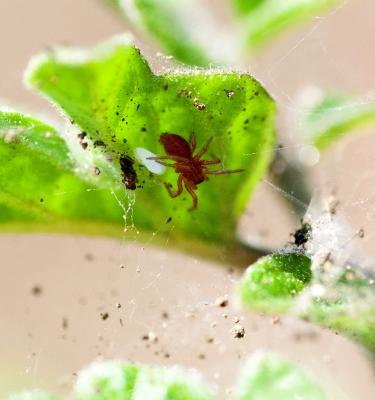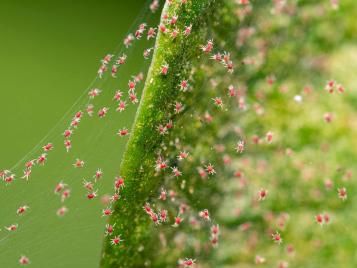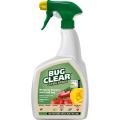

Red spider mites
The red spider mite is a very damaging plant pest. They are tiny and very difficult to see until they build up in large numbers and start producing their characteristic webbing. And, confusingly, they are rarely red!
Belonging to the same group of creatures as spiders, red spider mites have eight legs and their full name is ‘glasshouse red spider mite’ or GRSM (Tetranychus urticae). Red spider mites, like many insect plant pests, eat plant sap.
How to identify red spider mites
Red spider mites are perhaps the smallest of the common sap-feeding insects, being less than 1mm in size. They are so small you need a magnifying glass to identify them accurately and they are often easier to identify by examining the damage done to plants (see below). Despite their size, red spider mite damage can be extensive.
They like it warm and dry, which is why they can commonly be found indoors, on house plants or in conservatories or greenhouses. If the summer is dry and warm red spider mites in the UK can also be found outside from March to September where they can become a pest on beans, strawberries, raspberries, currants, roses and other ornamental plants.
For most of the year, red spider mites are not red at all – they are yellowish-green with two dark blotches towards the head. They turn red in the autumn and winter resting period. The larger, fast moving, bright red mites you sometimes see in the garden are actually red velvet mites and are not harmful to plants at all.

Red spider mite symptoms and damage
Leaves first develop a fine, pale mottling and become dull green. As the infestation progresses leaves turn yellowish white which can be mistaken for a mineral deficiency but look underneath the leaf with a magnifying glass and you will see the tiny red spider mites and their round eggs. Large colonies produce a characteristic fine silk webbing between leaves and stems. Plants shed their leaves, leaving just young leaves at the shoot tips.
How to get rid of red spider mites
You’ll find there are many methods of red spider mite control. Here we’ve listed a few different options, ranging from cultural and biological to chemical.
- If you find plants on the windowsill or in the greenhouse badly infested with red spider mites, remove the plants immediately. This is especially important in late summer before the females start to look for sheltered places to spend the winter once the temperature drops.
- In the greenhouse, use a biological treatment to combat red spider mite in the form of another species of mite which eats red spider mite. Phytoseiulus persimilis works best before the infestation becomes too big and needs a high daytime temperature to be effective. You can also try using it on outdoor plants in high summer. Avoid using an insecticide as it will also kill the biological control.
- Spray affected plants with a broad spectrum insecticide. You will need to apply it several times to break the red spider mite’s life cycle.
Before you treat red spider mite on fruit and vegetables, always check that the insecticide is approved for use on edible crops. To protect bees and pollinating insects do not apply to plants when in flower. Do not use where bees are actively foraging. Do not apply when flowering weeds are present.
How to prevent red spider mites
- Check susceptible plants frequently from March onwards so you can act before a red spider mite infestation takes hold.
- In the greenhouse maintain high humidity because plants grown at high temperatures in dry, overcrowded conditions are more liable to develop severe infestations of red spider mite.
- Clear out plant debris, old canes, stakes and plant-ties from the greenhouse before the spring and clean the empty greenhouse.
- Remove any weeds growing in or around the greenhouse because they may act as hosts for the mite.













